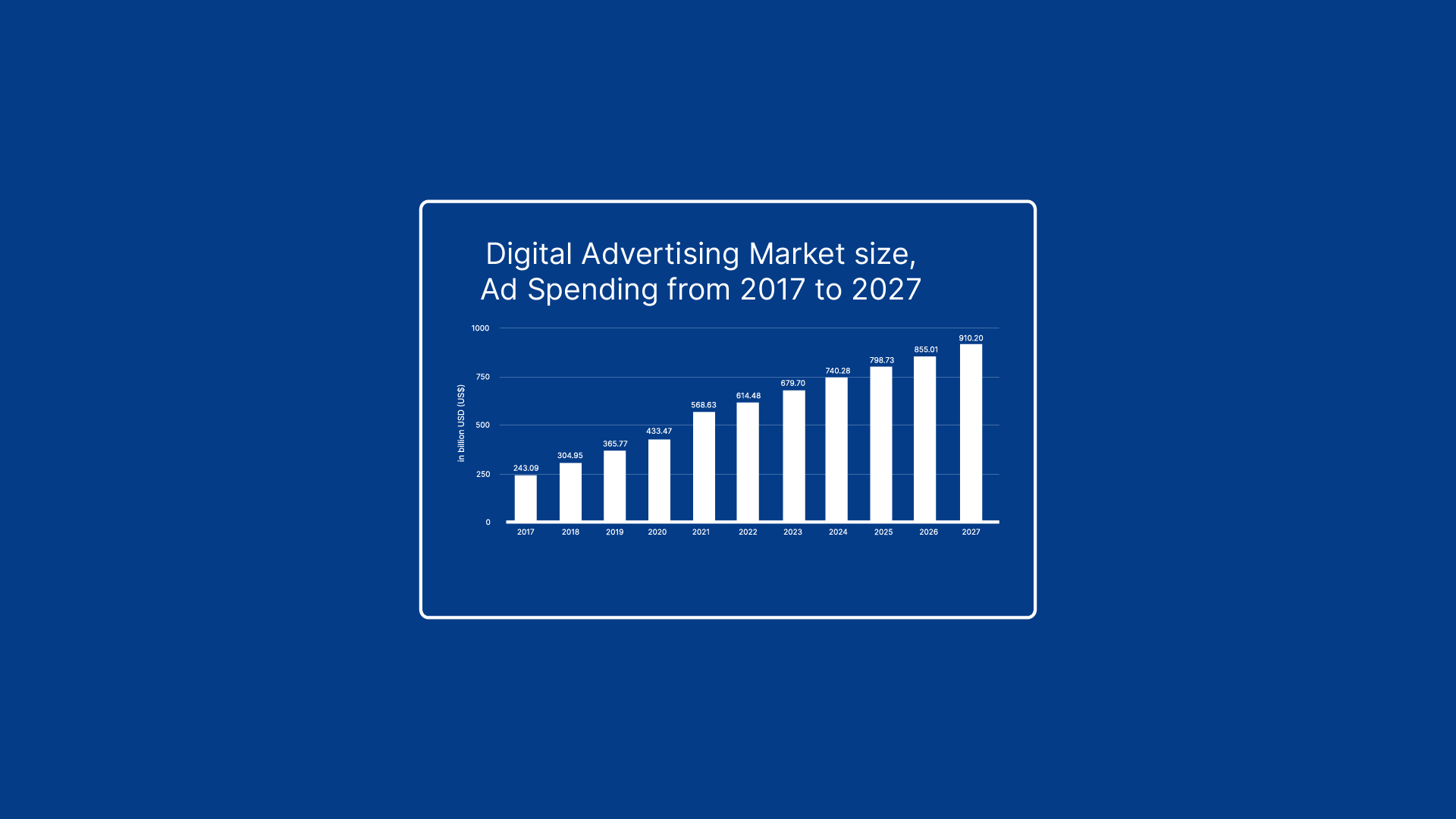|
Getting your Trinity Audio player ready...
|
Digital marketing is an ever-evolving field, with new trends and strategies constantly emerging. Staying updated on the latest trends is crucial for businesses and marketers to stay competitive in the online world.
In this article, we will explore some of the top digital marketing trends that are shaping the industry today and how you can leverage them to achieve success in your marketing efforts.
What are the Top Digital Marketing Trends?
1. AI Marketing Automation
AI marketing automation has emerged as a game-changer for businesses, allowing them to leverage the power of artificial intelligence to revolutionize their marketing efforts.
With AI, companies can analyze vast amounts of data that would be impossible for humans to process, enabling them to gain valuable insights and make data-driven decisions.
This integration of AI in marketing allows for more accurate targeting and personalization of customer experiences, leading to stronger customer relationships and increased revenue.
One notable example of AI-powered marketing automation is the use of chatbots and messaging apps. These tools have become instrumental in enhancing customer interactions by providing personalized experiences and instant solutions.
Businesses can deliver tailored content, recommendations, and support based on an individual’s preferences and previous interactions with the brand.
This not only improves customer satisfaction but also builds more authentic connections with customers, ultimately driving loyalty and advocacy.
Looking ahead, it is expected that these AI-powered marketing automation tools will become even more prevalent. Chatbots will continue to evolve, becoming even smarter and capable of handling more complex queries.
Predictive analytics tools will enable businesses to anticipate customer needs even before they arise, allowing for more proactive and personalized marketing strategies.
2. Social Media Influencer Marketing
In recent years, social media influencer marketing has skyrocketed in popularity. Influencers have become powerful advocates for brands, with their large followings and ability to connect with audiences on a personal level.
In today’s digital age, consumers have become increasingly discerning about the authenticity and credibility of influencers. Gone are the days when a simple endorsement from a well-known personality would suffice.
Modern consumers crave genuine connections and relationships with influencers who truly align with their values and interests.
This shift in consumer behavior is likely to drive the growth of micro-influencers, individuals who may have smaller followings but boast highly engaged audiences.
Micro-influencers, with their niche and targeted audiences, offer brands a unique opportunity to connect with specific segments of the market in a more meaningful way.
These individuals possess an intimate understanding of their followers and are often seen as relatable figures rather than distant celebrities.
By working with micro-influencers, brands can tap into these authentic relationships built on trust, thus establishing themselves as trustworthy and reliable entities in the eyes of consumers.
Moreover, micro-influencers tend to have higher engagement rates compared to larger influencers due to their dedicated fan base, resulting in increased reach and impact for brands looking to break through the cluttered online space.
Influencer marketing is evolving rapidly as consumers demand more than mere endorsements from popular figures. The rise of micro-influencers signifies a shift towards nurturing genuine connections between brands and consumers who share common values and interests.
3. Augmented Reality (AR) And Virtual Reality (VR)
Immersive technologies such as Augmented Reality (AR) and Virtual Reality (VR) have revolutionized the way brands engage with consumers. These technologies provide a unique opportunity for brands to create immersive brand storytelling experiences, allowing them to connect with their audience on a more personal and interactive level.
AR and VR can transport consumers into a virtual world where they can explore products, interact with brand mascots or characters, and be part of unforgettable experiences.
Through these mediums, brands can deliver their message in a captivating way, leaving a lasting impact on customers.
Looking ahead to 2024, we expect AR and VR to integrate even more deeply into strategic marketing efforts. As technology continues to evolve, we will see enhanced capabilities for creating hyper-realistic experiences that blur the lines between physical and virtual worlds. Brands will be able to leverage these advancements to create innovative campaigns that captivate audiences and build stronger connections.
For instance, e-tailers will greatly benefit from AR by offering virtual try-on experiences for customers. This allows users to visually see how a product looks on them before making a purchase, enhancing their shopping experience and increasing trust in the brand.
By embracing AR and VR in their marketing strategies, brands can elevate their storytelling capabilities while capturing attention in an increasingly competitive digital landscape.
4. Voice Search Optimization
With the rise of smart speakers and voice assistants, voice search has become a prominent aspect of digital marketing. According to Statista, the number of voice-enabled digital assistant users is expected to reach 8.4 billion by 2024. This presents a significant opportunity for brands to optimize their content and websites for voice search.
Voice search optimization is a crucial aspect of digital marketing in today’s rapidly evolving technological landscape. With the increasing popularity and usage of voice assistants, such as Siri, Alexa, and Google Assistant, businesses need to adapt their SEO strategies accordingly.
The statistics speak for themselves, with an estimated 200 million users of voice assistants in the U.S. alone. This represents a significant portion of the population that relies on voice search to find information, products, and services.
To ensure that your content stands out and ranks higher in voice search results, it is imperative to understand and implement voice search optimization techniques. One key approach is to use more conversational language in your content and focus on long-form questions when considering search queries and keywords.
Voice searches often involve natural language queries rather than traditional keyword-based searches. By incorporating conversational phrases and questions into your content strategy, you can increase the chances of matching what users are looking for through their voice commands.
Also, it is important to consider optimizing for local voice searches by including location-specific keywords or phrases related to your business. Many users rely on voice search to find nearby businesses or services, making local optimization crucial for discoverability. By tailoring your content to match these local intent queries, you can improve your chances of appearing in voice search results for users in your area.
5. The Rise of Personalization
Personalization has been a key trend in digital marketing, and it will continue to dominate the landscape in 2024. Customers today expect personalized experiences and tailored messaging from brands. With advancements in technology, brands now have access to vast amounts of data that allow them to understand their customers on a deeper level.
In 2024, we can expect to see even more sophisticated personalization strategies in digital marketing. Brands will leverage AI and machine learning algorithms to analyze customer data and create highly personalized campaigns. This includes personalized product recommendations, targeted emails, customized landing pages, and dynamic website content.
By leveraging AI and machine learning technologies, businesses now can truly understand their customers on an individual level. Take Brenda, for example, let’s assume she is an online buyer in a makeup store. As she explores an online makeup store, the platform’s AI engine works tirelessly in the background to analyze her past purchases, browsing history, and engagement patterns.
This wealth of information allows the engine to curate a personalized experience for Brenda, suggesting makeup-related accessories like lipsticks, and similar toner shades.
While hyper-personalization can enhance the customer experience, businesses must tread carefully when it comes to handling customer data.
Transparency becomes essential as companies need to communicate how they collect and use data from their customers. Obtaining explicit consent is crucial to building trust and maintaining ethical practices in data usage.
By being upfront about their intentions and ensuring secure storage of customer information, businesses can strike a balance between leveraging personalization technology and respecting privacy concerns.
Ultimately, responsible handling of customer data ensures that hyper-personalization remains a valuable tool in enhancing customer satisfaction without compromising individuals’ privacy.
6. Video Marketing
Video marketing is an essential tool for companies looking to captivate their audience and communicate their brand messages effectively. Short-form videos, which have gained immense popularity in recent years, are a fantastic way to grab viewers’ attention quickly and deliver key information concisely.
This format allows companies to showcase their products or services creatively, while also entertaining and engaging viewers. With the rise of platforms like TikTok, YouTube Shorts, and Instagram Reels, short videos have become even more prevalent and influential in reaching wider audiences.
Therefore, by incorporating short-form videos into their marketing strategy, companies can ensure that they stay ahead of the competition and leave a lasting impact on potential consumers.
In addition to short-form videos, live streaming has emerged as a powerful tool for brands to connect with their audience in real time.
Live streams offer an interactive experience that encourages viewer participation through comments, likes, and shares. By going live, companies can showcase events or product launches directly to viewers’ devices, allowing for instant engagement and feedback.
Moreover, live Q&A sessions enable brands to directly address customer inquiries and concerns. The ability to engage with customers on a personal level creates trust and loyalty among viewers while improving brand perception overall.
Hence, integrating live streaming into video marketing strategies enables companies to foster stronger relationships with their audience and stand out in a crowded digital landscape.
7. Omnichannel Marketing
In 2024, omnichannel marketing will continue to be a significant trend, as consumers expect a seamless and consistent experience across multiple channels. This means that businesses need to provide a cohesive brand message and customer journey across various touchpoints, including websites, social media platforms, mobile apps, and physical stores.
To achieve effective omnichannel marketing, businesses must invest in technology that enables seamless integration and communication between different channels. This includes implementing customer relationship management (CRM) systems that centralize customer data and allow for personalized and targeted marketing campaigns.
By utilizing data from various touchpoints, businesses can create a unified view of each customer’s preferences, behaviors, and interactions. This information can then be used to deliver personalized marketing messages and experiences, regardless of the channel.
Incorporating automation into omnichannel marketing strategies can help streamline processes and ensure consistent messaging. Automated workflows can be set up to deliver relevant content or promotions based on customer behavior and preferences, further enhancing the personalized experience.
8. User-Generated Content (UGC)
User-generated content (UGC) has become a key component of brand marketing strategies, as it provides social proof and engagement.
When consumers see others sharing their positive experiences with a brand or its products, it builds trust and credibility. UGC allows brands to tap into the power of word-of-mouth marketing by leveraging their existing customer base to promote their products or services.
By featuring UGC on their social media platforms or websites, brands can showcase real-life examples of how their offerings have positively impacted their customers’ lives.
To encourage UGC creation, brands often launch engaging contests and challenges with specific hashtags, themes, or formats. These initiatives provide incentives for users to share their experiences and creations related to the brand. By rewarding the best entries, brands not only motivate users to participate but also create a sense of excitement around their products and offerings.
Additionally, partnering with relevant influencers can amplify reach and engagement further. Influencers have loyal followers who trust their recommendations, so when these influencers join the UGC campaigns, it increases the likelihood of wider visibility and participation.
Involving the audience in content creation through UGC enhances brand credibility and customer loyalty. It empowers consumers by making them feel like valued contributors rather than passive spectators. This approach also allows brands to tap into the creativity and authenticity of their audience, resulting in more relatable and impactful content.
9. Social Commerce
Social commerce is a rapidly growing trend that combines the power of social media platforms with e-commerce. With more and more people using social media to discover products, follow brands, and seek recommendations from friends and influencers, it only makes sense for these platforms to integrate shopping features. Shortly, we can expect major players like Facebook, Instagram, and TikTok to provide users with a seamless shopping experience.
One of the key aspects of this integration will be streamlined shopping journeys. Instead of being redirected to external websites or apps to complete a purchase, users will be able to browse products and make purchases directly within the platform.
This will reduce friction in the buying process and make it easier for consumers to make impulsive purchases. Additionally, enhanced product discovery through tailored recommendations and sponsored content will help consumers find new products that align with their interests.
Immersive experiences are also expected to play a crucial role in social commerce. Platforms will offer features such as augmented reality (AR) try-on tools or virtual showrooms where customers can visualize products before making a purchase.
These immersive experiences not only offer convenience but also build trust by allowing customers to see how products would fit into their lives.
10. Privacy and Data Protection
As data privacy continues to be a pressing concern, businesses are realizing the importance of prioritizing consumer trust and data protection.
With an increasing number of high-profile data breaches and privacy scandals, customers are becoming more cautious about sharing their personal information. Therefore, companies that adopt robust data privacy practices and transparent data policies will gain a competitive advantage in the long run.
By 2024, it is predicted that consumers will gravitate toward businesses that prioritize data privacy and demonstrate a commitment to protecting personal information. To maintain customer trust and loyalty, it will be crucial for companies to implement secure methods of collecting and storing data.
This includes obtaining explicit consent from customers before collecting any personal information and regularly updating security measures to prevent unauthorized access.
Furthermore, compliance with evolving privacy regulations is essential for businesses looking to establish themselves as trustworthy custodians of customer data.
These regulations, such as the General Data Protection Regulation (GDPR) in Europe or the California Consumer Privacy Act (CCPA), are designed to protect individual privacy rights by imposing strict rules on how businesses collect, use, and store personal information.
Adhering to these laws not only helps companies avoid costly fines but also strengthens their reputation as responsible entities that prioritize user privacy.
11. Sustainability And Purpose-Driven Marketing
In recent years, sustainability has become a central factor in the purchasing decisions of consumers. As environmental concerns continue to escalate, individuals are seeking out brands that not only provide quality products or services but also align with their values and beliefs.
This has led to a rise in purpose-driven marketing strategies, where companies actively engage in initiatives that promote sustainability and social causes. However, it is crucial for businesses to go beyond mere lip service and truly embody these principles throughout their operations.
Authenticity is key when it comes to sustainable and purpose-driven marketing. Consumers are becoming increasingly savvy and can quickly identify if a brand’s commitment to sustainability is genuine or just a marketing tactic.
Therefore, companies must integrate sustainable practices into every aspect of their business and supply chain, rather than simply advertising eco-friendly initiatives.
By doing so, brands not only demonstrate their dedication to making a positive impact on the environment but also validate their purpose and build trust with consumers.
In today’s era of conscious consumerism, brands need to recognize the importance of communicating their commitment to sustainability effectively.
It is no longer sufficient just to have sustainable practices; companies must also effectively share these efforts with their target audience.
12. Customer Experience (CX) Elevation
In 2024, customer experience is predicted to become the focal point for chief marketing officers (CMOs), leading to increased investments in technologies and strategies that enhance the end-to-end customer journey.
This shift signifies a transformation in how marketers approach their interactions with consumers, as they recognize the significance of delivering a seamless and personalized experience.
By focusing on technologies such as artificial intelligence and data analytics, marketers will be able to gather valuable insights about their customers, enabling them to anticipate needs, personalize offerings, and refine overall customer satisfaction.
For marketers, this emphasis on customer experience means that they must redirect their efforts toward enhancing the customer journey. This requires employing cutting-edge technologies and implementing effective strategies to deliver smoother, more personalized, and satisfying interactions with brands.
The use of AI can provide real-time recommendations and personalized content to consumers based on their preferences and behavior patterns, creating a more tailored experience.
Additionally, leveraging data analytics can help identify areas for improvement in the customer journey and optimize processes for maximum efficiency. Marketers must also prioritize communication channels that allow for instant feedback and proactive problem-solving to address any issues or concerns before they escalate.
On the consumer side, this focus on elevating the customer experience brings promising prospects. Consumers can expect an enhanced and more personalized shopping experience, with brands anticipating their needs and delivering tailored recommendations. This can result in a more efficient and enjoyable shopping process.
13. Data Analytics Skills
In 2024, marketers can expect to have access to more advanced data analytics tools than ever before. With the emergence of Generative AI, the complexity of silos in marketing will be reduced, allowing for real-time access to data. This means that marketers will be able to derive actionable insights from the increasing volume of data available to them.
Generative AI will also facilitate chat-based insight discovery, making data analysis less complex for marketers. This means that marketers will be able to extract valuable insights quickly and easily from their data sets, helping them make more informed decisions and create more targeted marketing campaigns.
This advancement in data analytics will not only benefit marketers but also consumers. With access to more sophisticated data analytics tools, marketers will have a deeper understanding of consumers’ preferences and needs. As a result, consumers can expect to receive better and more relevant messages promptly, improving their overall experiences with brands and products.
Overall, the advancements in data analytics skills in 2024 will revolutionize the way marketers analyze and utilize data. This will lead to improved targeting, and messaging, and ultimately enhance the overall consumer experience by providing tailored content that matches their preferences and needs.







